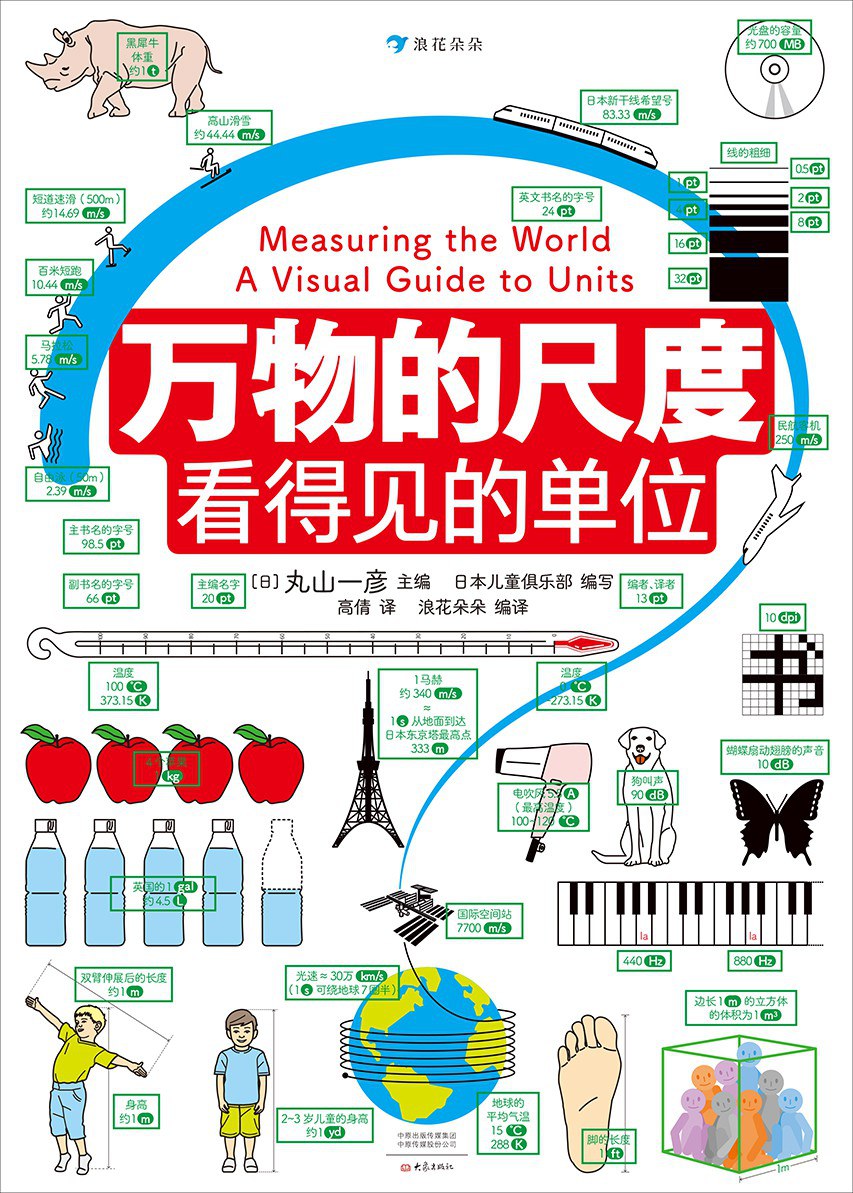WULOLIFE
《万物的尺度:看得见的单位》作者: [日] 丸山一彦出版社: 后浪 | 大象出版社
《万物的尺度:看得见的单位》作者: [日] 丸山一彦出版社: 后浪 | 大象出版社
Couldn't load pickup availability
Description
内容简介 · · · · · ·
用照片和图画让“单位”看得见,让近80种单位带来具体的感受。
单位是如何定义和命名的,节、马赫、加仑、桶、磅这些单位有什么方便?
理解似懂非懂的单位,提高对数理化的兴趣。
◎ 编辑推荐
☆ 用照片和图画,让抽象的物理单位带来具体的感受,让数理化更加亲切
1 page ——成人中指指甲盖的宽度;1 point个一元硬币的重量;1勒克斯有多亮——1只萤火虫发光的亮度;1摩尔有多少— —能组成30座富士山的沙粒的数量……用大量照片和图画来解释,让抽象的单位数理化课程中的抽象数据不再遥远。
☆
单位“米”是长度的单位,起初法国人将它确定为地球赤道到北极点的距离的100 0万分之1,后来又有改成光在真空中1/299792458秒内行进的距离。“马力”是因为詹姆斯·瓦特为了展示蒸汽机相对于马匹的出色能力,而设定的功率单位,后世为了纪念他的功绩。
☆ 清晰的条理和版式,分类详细介绍36种单位,并介绍约40种相关单位
分类介绍长度、面积、体积和容积、质量、与电有关以及用于表述巨大数字和微小数字的词头。分多个板块来建立立体的知识网络:来表示什么量、用什么符号,拓展知识,趣味小知识……
◎ 内容简介
数字+单位,是我们度量世界的方式。
在日常生活中我们经常会见到米、亩、秒、升、千克、吨等单位,还会接触到桶、牛顿、伏特、马力、瓦特、焦耳、赫兹、dpi甚至风级和震级等单位,但你真正知道这些单位是怎么确定的,有多长、多大、多快、多强吗?这本书用图鉴的方式帮助你理解近80种单位,让你能够更深入理解世界。
本书特点在于用十分形象的图画和照片向读者展示多种抽象单位的量,既可以作为课堂知识的补充,也可以作为趣味的课外延伸读物,有利于培养科学头脑。
◎ 媒体推荐
日本人凭直觉就能理解4.5张榻榻米和1升的瓶子的大小。但那些非公制的单位就难以理解,如桶、加仑等。这本书是一部图文并茂的精彩之作,对单位可视化进行了划时代的尝试。我小时候从电视剧《草原上的小房子》中知道了一亩是足球场的一半大小,两张榻榻米面积约1坪。最近,家电卖场的灯泡亮度从“瓦”改成了“流明”,这让我很困惑。我也搞不懂贝可勒尔和希沃特。但从这本书里都弄明白了。
——日本读者评论
一些大到难以想象或者很抽象的单位,虽然我们理论上知道,但在这本书中只用看一下图片就能明白了。也许正因为如此,书中大部分单位都用照片和图画展示,而且有通俗易懂的解释(起源、含义、用法等)。
在学习单位的时候,但我觉得单位基本上是和日常生活密切相关的东西,可以超出对应年级的理解范围,所以我觉得这本书适合作为小学生入学的礼物。不过,这本书内容非常多样,从熟悉的“米”到你也许从没听过的“开尔文”,而且讲得比较透彻……
我真的很推荐这本书,因为这是一本划时代的图鉴,它能让你直观地理解成年人都看似明白却只能模糊想象的单位。……我见过各种类型的绘本,是我见过的最先进的绘本之一,所以想买给自己的孩子。
——日亚读者评论
作者简介 · · · · · ·
主编:丸山一彦,1970年出生于日本三重县。日本成城大学经济学院经济学博士,曾任成城大学经济研究所研究员、日本明治大学理工学院讲师、日本富山短期大学经营情报系教授,现任日本和光大学经济学院工商管理系副教授。研究领域涉及创新设计、新产品开发管理、市场战略、购买行为分析等。
编写:日本儿童俱乐部,主要从事儿童书籍的策划和编辑,主要涉及儿童游戏、教育和福利领域。代表作有《身边的科学》《宝宝看图学英语图鉴》《小学英语图鉴》 《日本的工业》《自然灾害的认识和预防》《历史实物大图鉴》《汽车大全图鉴》《 popular
